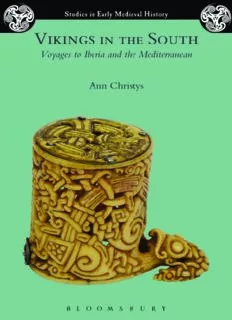
Vikings in the South: Voyages to Iberia and the Mediterranean PDF
Preview Vikings in the South: Voyages to Iberia and the Mediterranean
Vikings in the South i Studies in Early Medieval History Series editor: Ian Wood Concise books on current areas of debate in late antiquity/early medieval studies, covering history, archaeology, cultural and social studies, and the interfaces between them. Dark Age Liguria: Regional Identity and Local Power, c. 400–1020 , Ross Balzaretti Inventing Byzantine Iconoclasm, Leslie Brubaker Pagan Goddesses in the Early Germanic World: Eostra, Hreda and the Cult of Matrons , Philip A. Shaw ii Vikings in the South Voyages to Iberia and the Mediterranean Ann Christys Bloomsbury Academic An imprint of Bloomsbury Publishing Plc iii Bloomsbury Academic An imprint of Bloomsbury Publishing Plc 50 Bedford Square 1385 Broadway London New York WC1B 3DP NY 10018 U K USA www.bloomsbury.com BLOOMSBURY and the Diana logo are trademarks of Bloomsbury Publishing Plc First published 2015 © Ann Christys, 2015 Ann Christys has asserted her right under the Copyright, Designs and Patents Act, 1988, to be identifi ed as Author of this work. All rights reserved. No part of this publication may be reproduced or transmitted in any form or by any means, electronic or mechanical, including photocopying, recording, or any information storage or retrieval system, without prior permission in writing from the publishers. No responsibility for loss caused to any individual or organization acting on or refraining from action as a result of the material in this publication can be accepted by Bloomsbury or the author. British Library Cataloguing- in-Publication Data A catalogue record for this book is available from the British Library. I SBN: HB: 978-1-47421-376-9 P B: 978-1-47421-375-2 e PDF: 978-1-47421-378-3 e Pub: 978-1-47421-377-6 Library of Congress Cataloging- in-Publication Data A catalog record for this book is available from the Library of Congress. Series: Studies in Early Medieval History Typeset by Refi neCatch Limited, Bungay, Suffolk iv Contents List of Illustrations vii Preface and Acknowledgements ix 1 Introduction: Don Teudo Rico Defeats a Viking Raid 1 2 From the Encircling Ocean 15 3 So the Story Goes 29 4 A Mediterranean Adventure 47 5 Waiting for the Barbarians 65 6 Th e Wars of Santiago and Cordoba against Vikings 79 7 Conclusion: From Charter and Chronicle to Saga 95 Appendix 1: Glossary of Histories and Historians 105 Appendix 2: Timeline 109 Abbreviations 111 Bibliography 113 Index 131 v vi List of Illustrations 0.1 Th e fi rst expeditions xii 0.2 Th e Iberian peninsula xii 0.3 Galicia xiii 1.1 Th e Luarca plaque 2 1.2 Santa María del Naranco, Oviedo 10 5.1 R ibā t. of Monastir 72 5.2 River Miño at Tuy 74 5.3 Th e Torres del Oeste 76 5.4 Replica Viking ships at Catoira, Ría de Arousa 77 6.1 Madīnat al-Zahrā’ 89 6.2 Th e Eastern Gate, Madīnat al-Zahrā’ 90 vii viii Preface and Acknowledgements Several years ago, I spent a halcyon aft ernoon sailing or, to be more truthful, becalmed in a replica Viking ship with a group of eminent scholars of the Viking Age who were meeting at the Roskilde Ship Museum. Peter Sawyer suggested that, as I had studied the Latin and Arabic historiography of medieval Iberia, I might look at the evidence for Vikings in the peninsula. Peter’s request was prompted by the ‘Bibliographia Normanno-Hispanica’ published the year before in the S aga Book . He was conscious that treatment of Iberia in general histories, including his own O xford History of the Vikings, was brief. In her chapter on the Vikings in Francia, Jinty Nelson had noted that: Occasionally Vikings ventured far beyond the Carolingian realms. In 844 Galicia and al-Andalus were raided. In 859 (according to the annals of St-Bertin for that year) ‘Danish pirates made a long sea- voyage, sailed through the straits between Spain and Africa and then up the Rhône. Th ey ravaged some towns and monasteries and made their base on an island called the Camargue.’ Muslim sources of the tenth century and later record other episodes on this voyage: al-Andalus was raided, and then the little Moroccan state of Nakur, whose royal women were carried off , then handed back aft er ransoms were paid by the amir of Córdoba; ‘more than forty ships’ were lost on the way home; and, perhaps a fi nal success on the same expedition, the king of Pamplona was captured and ransomed in 861 for 60,000 gold pieces. A basis of historical fact thus underlies the epic Mediterranean journey described in the later medieval Hiberno-Norse version of R agnar’s Saga . All this was spectacular but exceptional. (Sawyer 1997: 29–30) Hispanists are used to being exceptional, to existing in the margins of general histories of the Middle Ages. Jinty’s exemplary summary of the more important Viking exploits in the South and the intriguing stories attached to them was a further incitement to take up the challenge to bring these Vikings into the main body of the text. ix
Description: